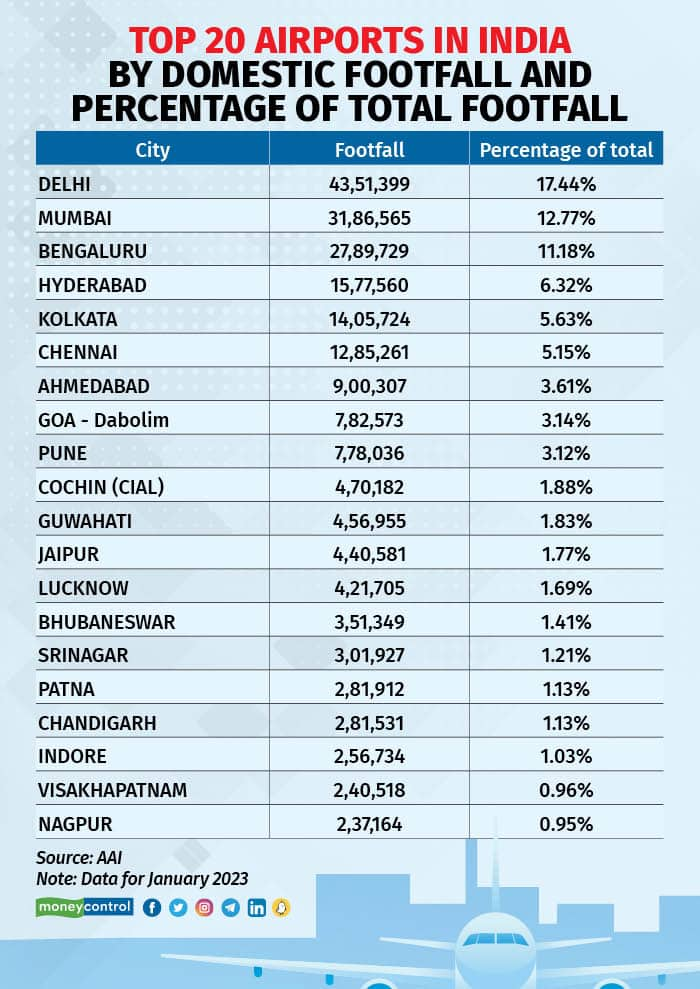



The Pareto Rule, popularly referred to as the 80-20 rule, which asserts that 80 percent of the outcomes come from 20 percent of inputs, seems to be the norm in Indian aviation as well.
For domestic air travel, the top 20 airports contribute 83 percent of the total footfalls. This is so even as new airports get operationalised at breakneck speed – 74 airports have started or have been built in the past nine years.
What this means for airlines
Any airline looking for a large chunk of traffic or trying to slice away some traffic has to be present at these top 20 airports. Not doing so could mean letting go of a large share of traffic.
Airline schedules show that the top seven airlines are present or have announced their presence at the top six airports, which account for over 50 percent of the footfalls.
The market starts thinning beyond the metros. In fact, the last two airports in the top 20 each has less than 1 percent of the total footfalls, an indicator of how skewed the market is. However, compared with the past, things are changing. In January 2018, the top six airports had 60 percent of the traffic.
IndiGo is the only carrier present in all 20 markets. Air India is next with a presence in 19 out of the 20 markets. The airline recently gave up operations at Bhubaneshwar to AirAsia India as part of its network reorganisation plan. This is followed by Vistara’s presence in 18 of the top airports.
Regional challenges
An airline has to choose between taking a small slice of a larger pie or a larger slice of a smaller pie. Regional connectivity schemes like UDAN let airlines create their own pie, but there is a lot of uncertainty around it.
Airlines that were formed to predominantly benefit from UDAN have not done well, with Air Odisha and Air Deccan shutting shop very early in their lifecycle and Trujet not being able to sustain itself either. Star Air, which recently inducted one E175 aircraft and has three more on order, is also making losses.
One of the reasons is traffic percentage. Airlines rely on a small amount of the total traffic, which is more prone to shifting to other modes of transport.
A look at the numbers of airports such as Rupasi, Sindhudurg, Kurnool, and Bilaspur shows that footfalls are 0.01 percent of the total. Yet, while it may look small in the overall scheme of things, they mean a lot for these places, which include a mix of new airports as well as very old air strips that have been revived to connect them to the world. But the numbers tell a story of how subsidised travel will have to continue for longer.
The UDAN scheme envisioned that routes would mature after three years, but not many have progressed on that front, with many airports dropping off the air map after the three-year period due to lack of viability or airlines going bust.
Focus needed on large airports
While efforts to build more airports and connect more parts of the country are laudable, it is equally – if not more – important to augment capacity in the metros. A cursory look at the numbers shows that there is limited potential to operate between tier 2 cities or between tier 2 and tier 3 cities and vice versa.
To connect more airports to the top 20 airports in the country means adding capacity in the top 20, most of which are saturated or on the verge of getting congested.
Bengaluru has already invested in a new terminal and runway, while Delhi and Hyderabad are in the middle of expansion. Mumbai, sadly, has no scope to add either a terminal or a runway.
New airports at Jewar near Noida and Navi Mumbai are being built, which will help add capacity to the Delhi and Mumbai regions but efforts should be made to increase air traffic movement at the existing airports - with a mix of upgraded radar and navigational infrastructure along with the construction of rapid exit taxiways, among other things.
Top 20 airports in India by domestic footfall and percentage of total footfall

Which airlines operate to top 20 airports by domestic footfall in India

Discover the latest Business News, Sensex, and Nifty updates. Obtain Personal Finance insights, tax queries, and expert opinions on Moneycontrol or download the Moneycontrol App to stay updated!
Find the best of Al News in one place, specially curated for you every weekend.
Stay on top of the latest tech trends and biggest startup news.